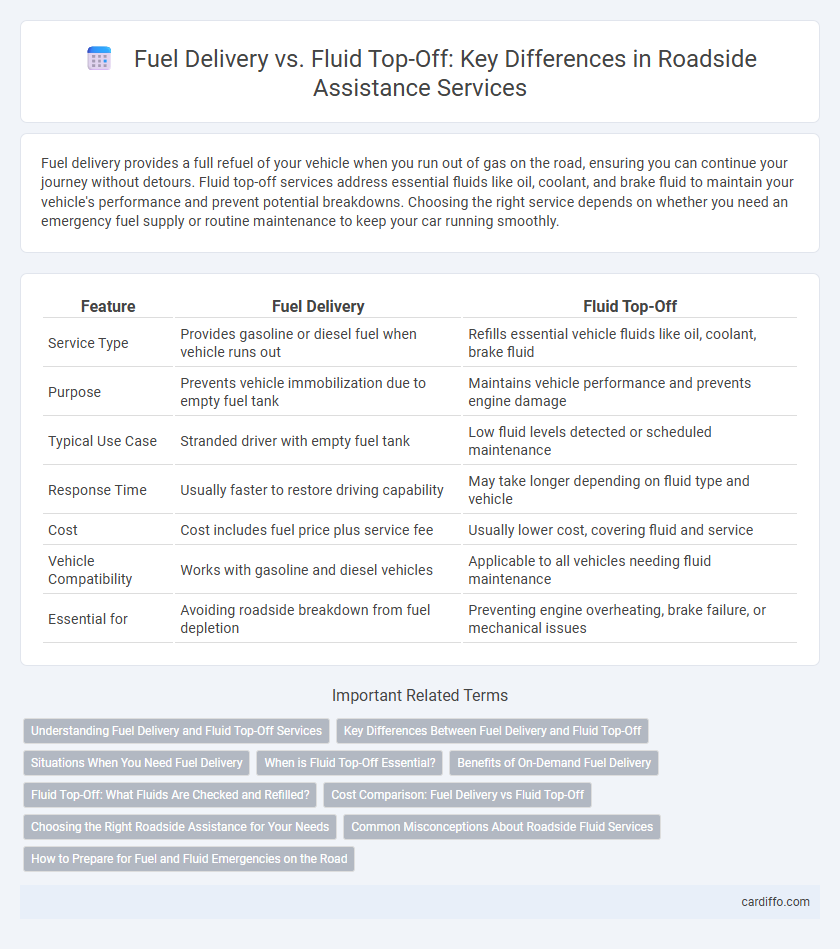Fuel delivery provides a full refuel of your vehicle when you run out of gas on the road, ensuring you can continue your journey without detours. Fluid top-off services address essential fluids like oil, coolant, and brake fluid to maintain your vehicle's performance and prevent potential breakdowns. Choosing the right service depends on whether you need an emergency fuel supply or routine maintenance to keep your car running smoothly.
Table of Comparison
| Feature | Fuel Delivery | Fluid Top-Off |
|---|---|---|
| Service Type | Provides gasoline or diesel fuel when vehicle runs out | Refills essential vehicle fluids like oil, coolant, brake fluid |
| Purpose | Prevents vehicle immobilization due to empty fuel tank | Maintains vehicle performance and prevents engine damage |
| Typical Use Case | Stranded driver with empty fuel tank | Low fluid levels detected or scheduled maintenance |
| Response Time | Usually faster to restore driving capability | May take longer depending on fluid type and vehicle |
| Cost | Cost includes fuel price plus service fee | Usually lower cost, covering fluid and service |
| Vehicle Compatibility | Works with gasoline and diesel vehicles | Applicable to all vehicles needing fluid maintenance |
| Essential for | Avoiding roadside breakdown from fuel depletion | Preventing engine overheating, brake failure, or mechanical issues |
Understanding Fuel Delivery and Fluid Top-Off Services
Fuel delivery services provide motorists with immediate refueling solutions when vehicles run out of gas, offering convenience and time savings during roadside emergencies. Fluid top-off services involve replenishing essential automotive fluids such as engine oil, coolant, brake fluid, and windshield washer fluid to maintain optimal vehicle performance. Both services are crucial for preventing breakdowns and ensuring vehicle reliability, especially during long trips or in remote areas.
Key Differences Between Fuel Delivery and Fluid Top-Off
Fuel delivery provides a specific amount of gasoline or diesel directly to the vehicle's fuel tank, ensuring the engine continues running without interruption. Fluid top-off involves replenishing essential vehicle fluids such as engine oil, coolant, brake fluid, or windshield washer fluid to maintain optimal vehicle performance. Key differences include the targeted substance--fuel versus various fluids--and the purpose, with fuel delivery aimed at immediate vehicle operation and fluid top-off focused on long-term maintenance.
Situations When You Need Fuel Delivery
Fuel delivery is essential during unexpected fuel depletion when a vehicle cannot reach a gas station, especially on long trips or in remote areas. It ensures drivers avoid being stranded by providing the exact type of fuel needed to restart the engine safely. Fluid top-off services, by contrast, address maintenance needs like coolant or oil levels but do not replace the urgency and necessity of refueling a depleted gas tank.
When is Fluid Top-Off Essential?
Fluid top-off is essential when a vehicle's coolant, brake fluid, or windshield washer fluid levels are low but not critical enough to require a full fuel delivery. Regular fluid top-offs maintain optimal vehicle performance and prevent breakdowns caused by overheating, brake failure, or impaired visibility. This service is particularly crucial during seasonal changes or long-distance travel when fluid consumption increases.
Benefits of On-Demand Fuel Delivery
On-demand fuel delivery offers immediate refueling directly at the roadside, eliminating the need for drivers to locate a gas station and reducing downtime. This service enhances safety by preventing stranded vehicles in hazardous locations and supports commercial fleets with quick, scheduled fuel replenishment. Compared to fluid top-off, fuel delivery provides a complete fuel supply solution, ensuring vehicles remain operational without interrupting travel or work schedules.
Fluid Top-Off: What Fluids Are Checked and Refilled?
Fluid top-off services typically include checking and replenishing essential vehicle fluids such as engine oil, coolant, brake fluid, windshield washer fluid, and power steering fluid. These fluids are vital for maintaining proper engine function, vehicle safety, and optimal performance during roadside assistance. Regular fluid top-offs prevent breakdowns by ensuring all systems operate smoothly and efficiently.
Cost Comparison: Fuel Delivery vs Fluid Top-Off
Fuel delivery services typically incur higher costs due to the quantity of fuel provided and the specialized equipment required for transport and dispensing. Fluid top-off services, covering engine oil, coolant, brake fluid, and windshield washer fluid, generally cost less as they involve smaller volumes and simpler handling. Comparing average roadside assistance fees, fuel delivery often ranges from $50 to $100, whereas fluid top-offs usually cost between $20 and $50.
Choosing the Right Roadside Assistance for Your Needs
Fuel delivery services provide a complete tank refill when you run out of gas, ensuring you reach the nearest station without delay, while fluid top-off addresses essential maintenance needs like brake fluid, coolant, and windshield wiper fluid. Choosing the right roadside assistance depends on the specific issue: fuel delivery is critical for immediate mobility, whereas fluid top-off prevents potential vehicle breakdowns and maintains optimal engine performance. Evaluating your vehicle's condition and driving habits helps determine whether emergency fuel supply or routine fluid maintenance best suits your roadside support needs.
Common Misconceptions About Roadside Fluid Services
Many drivers confuse fuel delivery with fluid top-off services, assuming both cover essential roadside fluids like engine oil, transmission fluid, and coolant. Fuel delivery strictly involves providing gasoline or diesel when a vehicle runs out, while fluid top-off addresses replenishing specific automotive fluids to maintain vehicle health and prevent breakdowns. Understanding the distinction helps avoid delays and ensures appropriate roadside assistance tailored to the vehicle's immediate needs.
How to Prepare for Fuel and Fluid Emergencies on the Road
Preparing for fuel and fluid emergencies on the road involves keeping an emergency kit with essential items such as a portable gas can, spare engine oil, coolant, and windshield washer fluid. Regularly checking fluid levels before long trips can prevent unexpected breakdowns and ensure vehicle performance. Knowing the location of nearby fuel delivery services and roadside assistance providers enhances readiness and reduces downtime during emergencies.
Fuel Delivery vs Fluid Top-Off Infographic

 cardiffo.com
cardiffo.com